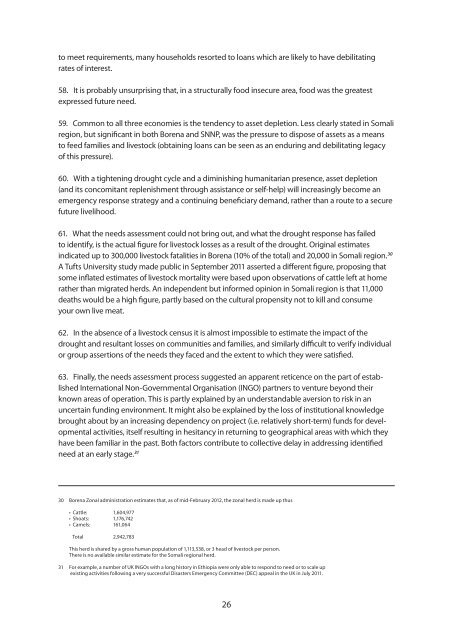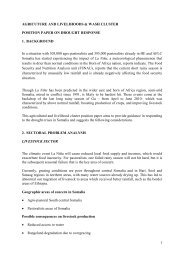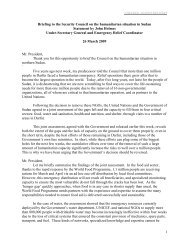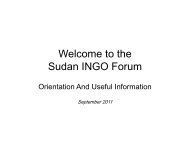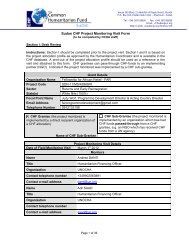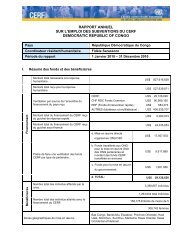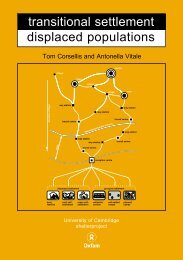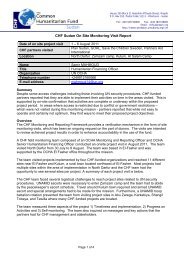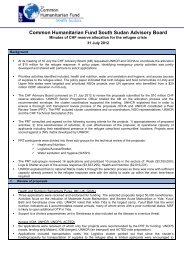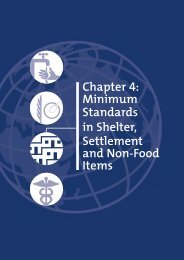Ethiopia - OCHANet
Ethiopia - OCHANet
Ethiopia - OCHANet
You also want an ePaper? Increase the reach of your titles
YUMPU automatically turns print PDFs into web optimized ePapers that Google loves.
to meet requirements, many households resorted to loans which are likely to have debilitating<br />
rates of interest.<br />
58. It is probably unsurprising that, in a structurally food insecure area, food was the greatest<br />
expressed future need.<br />
59. Common to all three economies is the tendency to asset depletion. Less clearly stated in Somali<br />
region, but significant in both Borena and SNNP, was the pressure to dispose of assets as a means<br />
to feed families and livestock (obtaining loans can be seen as an enduring and debilitating legacy<br />
of this pressure).<br />
60. With a tightening drought cycle and a diminishing humanitarian presence, asset depletion<br />
(and its concomitant replenishment through assistance or self-help) will increasingly become an<br />
emergency response strategy and a continuing beneficiary demand, rather than a route to a secure<br />
future livelihood.<br />
61. What the needs assessment could not bring out, and what the drought response has failed<br />
to identify, is the actual figure for livestock losses as a result of the drought. Original estimates<br />
indicated up to 300,000 livestock fatalities in Borena (10% of the total) and 20,000 in Somali region. 30<br />
A Tufts University study made public in September 2011 asserted a different figure, proposing that<br />
some inflated estimates of livestock mortality were based upon observations of cattle left at home<br />
rather than migrated herds. An independent but informed opinion in Somali region is that 11,000<br />
deaths would be a high figure, partly based on the cultural propensity not to kill and consume<br />
your own live meat.<br />
62. In the absence of a livestock census it is almost impossible to estimate the impact of the<br />
drought and resultant losses on communities and families, and similarly difficult to verify individual<br />
or group assertions of the needs they faced and the extent to which they were satisfied.<br />
63. Finally, the needs assessment process suggested an apparent reticence on the part of established<br />
International Non-Governmental Organisation (INGO) partners to venture beyond their<br />
known areas of operation. This is partly explained by an understandable aversion to risk in an<br />
uncertain funding environment. It might also be explained by the loss of institutional knowledge<br />
brought about by an increasing dependency on project (i.e. relatively short-term) funds for developmental<br />
activities, itself resulting in hesitancy in returning to geographical areas with which they<br />
have been familiar in the past. Both factors contribute to collective delay in addressing identified<br />
need at an early stage. 31<br />
30 Borena Zonal administration estimates that, as of mid-February 2012, the zonal herd is made up thus<br />
• Cattle: 1,604,977<br />
• Shoats: 1,176,742<br />
• Camels: 161,064<br />
Total 2,942,783<br />
This herd is shared by a gross human population of 1,113,538, or 3 head of livestock per person.<br />
There is no available similar estimate for the Somali regional herd.<br />
31 For example, a number of UK INGOs with a long history in <strong>Ethiopia</strong> were only able to respond to need or to scale up<br />
existing activities following a very successful Disasters Emergency Committee (DEC) appeal in the UK in July 2011.<br />
26


